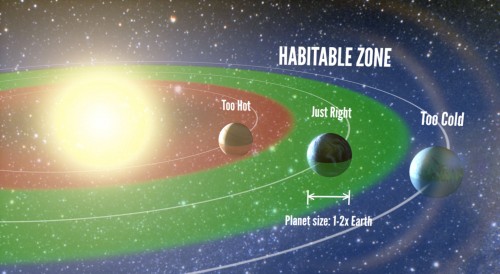
Are Earth-like planets very common? (Courtesy: Petigura/UC Berkeley, Howard/UH-Manoa, Marcy/UC Berkeley)
By Hamish Johnston
A decade or so ago it would have been reasonable to wonder if the universe contained any planets that resemble Earth. But now that astronomers have discovered more than 1000 planets orbiting stars other than the Sun, it seems perfectly sensible to think that the number of Earth-like planets could be huge. However, actually finding such planets remains a challenge.
The problem is that today’s telescopes are not good enough to spot other “Earths” – rocky planets orbiting in the habitable zones of Sun-like planets. The habitable zone of a star comprises the not-too-hot and not-too-cold orbits similar to that of the Earth where life as we know it could emerge (see figure).
But that hasn’t stopped Erik Petigura and Geoffrey Marcy of the University of California, Berkeley and Andrew Howard of the University of Hawaii from estimating what percentage of Sun-like stars could have an Earth-like planet in the habitable zone.
They reckon that the figure is 22%, which suggests that the nearest such planet could be a mere 12 light-years away – really just next door.
The team came to this conclusion using data from the Kepler space telescope. Kepler was launched in 2009 to search for distant planets and ceased operation earlier this year. The researchers focused on about 42,000 stars that are like the Sun and could be imaged with relatively low levels of noise. The aim of the search was to look for evidence of the periodic dimming that occurs when a planet passes between its star and Earth, causing a tiny reduction in the amount of light reaching us.
The team found evidence for 10 planets that are about 1–2 times the mass of Earth and receive comparable amounts of stellar energy. While this is clearly not 22%, the trio points out that these measurements were made right on the edge of Kepler’s capabilities and so it is likely that many more planets were missed by the search. To try to work out how many were not seen, the astronomers injected simulated planets into the Kepler data and counted how many were detected. Using this information, they concluded that about 22% of the stars they studied probably do have Earth-like planets.
“If the stars in the Kepler field are representative of stars in the solar neighbourhood…then the nearest (Earth-size) planet is expected to orbit a star that is less than 12 light-years from Earth and can be seen by the unaided eye,” say the astronomers.
This doesn’t mean that all of these planets have similar atmospheres to Earth, and it certainly doesn’t suggest that they all harbour life. But it’s something to think about the next time you gaze upon a starry sky.
The results are described in a paper published in the Proceedings of the National Academy of Sciences entitled “Prevalence of Earth-size planets orbiting Sun-like stars“.
In my opinion, the right question here is: how many Earth-like planets have a moon, lile ours, so massive, so near?
Such a moon is a must have for a planet to be like our Earth. Among other things, for two reasons.
(1) Jacques Laskar, researcher at CNRS, has shown how the Moon stabilizes the Earth’s axial tilt. Otherwise, there would be extreme and frequent changes in the climate, which would hinder any forms of life on our planet.
(2) Without the Moon, the seeds here on the Earth would diminish their viability for good, and would be not able to recover it at a later time. Indeed the seeds elude the second law of thermodynamics, at this particular time let me put it this way, by implementing a clever trick. When the Moon delay with regard to the Earth is increasing, the seeds would tend to increase the energy of their configurations, and to diminish the fluidity of their fatty acids, along with their viability. Instead, when the Moon is decreasing its delay, the seeds would tend to dissipate the energy of their configurations, would create order between adjacent molecules, would increase the fluidity of their fatty acids, along with their viability.
Salutations Pietro Baruffaldi
Trackback: Blog - physicsworld.com